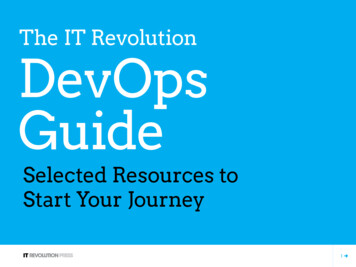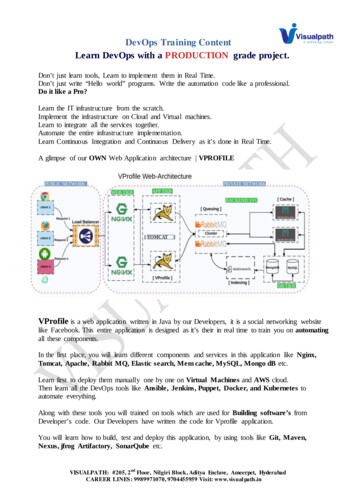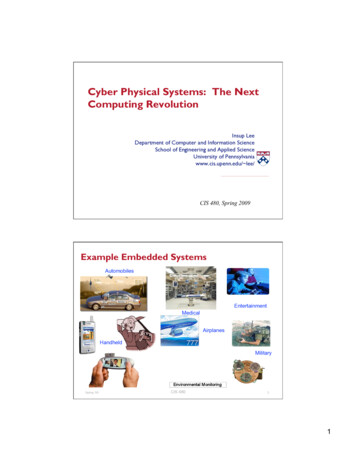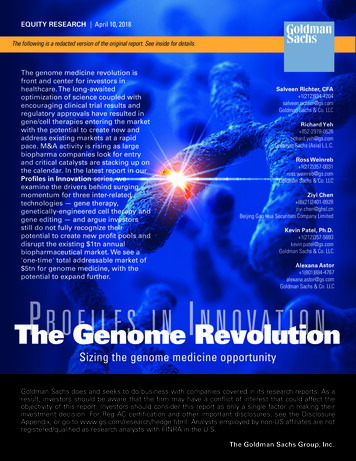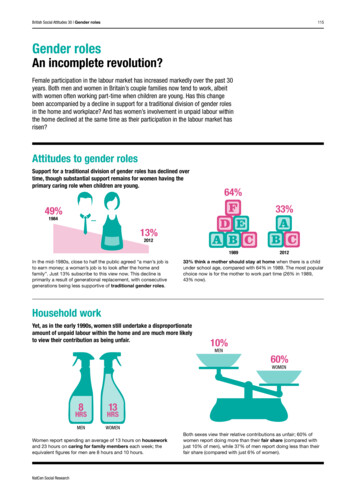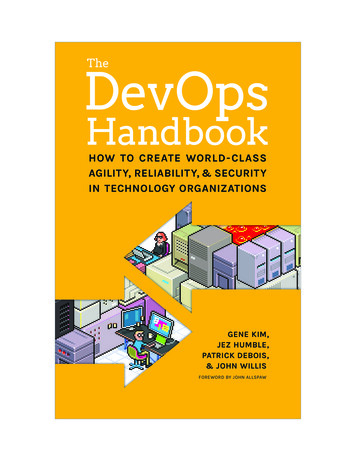
Transcription
lesaorbutionTHE DEVOPSHANDBOOKomo-NotfordistriHow to Create World-ClassAgility, Reliability, & Security inTechnology OrganizationsPrBy Gene Kim, Jez Humble, Patrick Debois, and John Willis
IT Revolution Press, LLC25 NW 23rd Pl, Suite 6314Portland, OR 97210Copyright 2016 by Gene Kim, Jez Humble, Patrick Debois, and John WillissaleAll rights reserved, for information about permission to reproduce selections from this book,write to Permissions, IT Revolution Press, LLC, 25 NW 23rd Pl, Suite 6314, Portland, OR 97210First EditionorPrinted in the United States of AmericaCover illustration by eboytioCover design by Strauber Design Studion10 9 8 7 6 5 4 3 2 1buBook design by Mammoth CollectiveistriISBN: 978-1942788003-NotfordPublisher’s note to readers: Many of the ideas, quotations, and paraphrases attributed todifferent thinkers and industry leaders herein are excerpted from informal conversations,correspondence, interviews, conference roundtables, and other forms of oral communicationthat took place over the last six years during the development and writing of this book.Although the authors and publisher have made every effort to ensure that the information inthis book was correct at press time, the authors and publisher do not assume and herebydisclaim any liability to any party for any loss, damage, or disruption caused by errors oromissions, whether such errors or omissions result from negligence, accident,or any other cause.PromoThe author of the 18F case study on page 325 has dedicated the work to the public domain bywaiving all of his or her rights to the work worldwide under copyright law, including all relatedand neighboring rights, to the extent allowed by law. You can copy, modify, distribute, andperform case study 18F, even for commercial purposes, all without asking permission.For information about special discounts for bulk purchasesor for information on booking authors for an event,please visit ITRevolution.com.THE DEVOPS HANDBOOK
oomProt-Ntiobuistrirdfonorsale
saleTABLE OF CONTENTSnorPreface xiForeword xixImagine a World Where Dev and Ops Become DevOps:An Introduction to The DevOps Handbook xxirdistributioPART I—THE THREE WAYS 1Part I Introduction 31 Agile, Continuous Delivery, and the Three Ways 72 The First Way: The Principles of Flow 153 The Second Way: The Principles of Feedback 274 The Third Way: The Principles of Continual Learningand Experimentation 37omo-NotfoPART II—WHERE TO START Part II Introduction 5 Selecting Which Value Stream to Start With 6 Understanding the Work in Our Value Stream, Making it Visible,and Expanding it Across the Organization 7 How to Design Our Organization and Architecturewith Conway’s Law in Mind 8 How to Get Great Outcomes by Integrating Operationsinto the Daily Work of Development PrPART III—THE FIRST WAY:THE TECHNICAL PRACTICES OF FLOW Part III Introduction 9 Create the Foundations of Our Deployment Pipeline 10 Enable Fast and Reliable Automated Testing 11 Enable and Practice Continuous Integration 12 Automate and Enable Low-Risk Releases 13 Architect for Low-Risk Releases 474951617795107109111123143153179
sa215le191193195227241249tionorPART IV—THE SECOND WAY:THE TECHNICAL PRACTICES OF FEEDBACK Part IV Introduction 14 Create Telemetry to Enable Seeing and Solving Problems 15 Analyze Telemetry to Better Anticipate Problemsand Achieve Goals 16 Enable Feedback So Development and OperationsCan Safely Deploy Code 17 Integrate Hypothesis-Driven Development andA/B Testing into Our Daily Work 18 Create Review and Coordination Processes toIncrease Quality of Our Current Work 267269271287299fordistribuPART V—THE THIRD WAY:THE TECHNICAL PRACTICES OF CONTINUAL LEARNINGAND EXPERIMENTATION Part V Introduction 19 Enable and Inject Learning into Daily Work 20 Convert Local Discoveries into Global Improvements 21 Reserve Time to Create Organizational Learningand Improvement omo-NotPART VI—THE TECHNOLOGICAL PRACTICES OFINTEGRATING INFORMATION SECURITY, CHANGEMANAGEMENT, AND COMPLIANCE 309Part VI Introduction 31122 Information Security as Everyone’s Job, Every Day 31323 Protecting the Deployment Pipeline, and Integrating into ChangeManagement and Other Security and Compliance Controls 333Conclusion to the DevOps Handbook:A Call to Action 347PrADDITIONAL MATERIAL 351Appendices 353Additional Resources 366Endnotes 370Index 409Acknowledgments 435Author Biographies 439
oomProt-NtiobuistrirdfoTHE DEVOPSHANDBOOKnorsale
salePrefaceAha!tionorThe journey to complete The DevOps Handbook has been a long one—it startedwith weekly working Skype calls between the co-authors in February of 2011,with the vision of creating a prescriptive guide that would serve as a companionto the as-yet unfinished book The Phoenix Project: A Novel About IT, DevOps,and Helping Your Business Win.otGene KimfordistribuMore than five years later, with over two thousand hours of work, The DevOpsHandbook is finally here. Completing this book has been an extremely longprocess, although one that has been highly rewarding and full of incrediblelearning, with a scope that is much broader than we originally envisioned.Throughout the project, all the co-authors shared a belief that DevOps isgenuinely important, formed in a personal “aha” moment much earlier ineach of our professional careers, which I suspect many of our readers willresonate with.Promo-NI’ve had the privilege of studying high-performing technology organizations since 1999, and one of the earliest findings was that boundary-spanning between the different functional groups of IT Operations,Information Security, and Development was critical to success. But Istill remember the first time I saw the magnitude of the downwardspiral that would result when these functions worked toward opposing goals.It was 2006, and I had the opportunity to spend a week with the groupwho managed the outsourced IT Operations of a large airline reservation service. They described the downstream consequences of theirlarge, annual software releases: each release would cause immensechaos and disruption for the outsourcer, as well as customers; therewould be SLA (service level agreement) penalties, because of thecustomer-impacting outages; there would be layoffs of the most
orsaThe sense of hopelessness and futility that resulted created for methe beginnings of a moral crusade. Development seemed to alwaysbe viewed as strategic, but IT Operations was viewed as tactical, oftendelegated away or outsourced entirely, only to return in five years inworse shape than it was first handed over.letalented and experienced staff, because of the resulting profit shortfalls; there would be much unplanned work and firefighting so thatthe remaining staff couldn’t work on the ever-growing service requestbacklogs coming from customers; the contract would be held togetherby the heroics of middle management; and everyone felt that thecontract would be doomed to be put out for re-bid in three years.foJez HumblerdistributionFor many years, many of us knew that there must be a better way. Iremember seeing the talks coming out of the 2009 Velocity Conference,describing amazing outcomes enabled by architecture, technicalpractices, and cultural norms that we now know as DevOps. I was soexcited, because it clearly pointed to the better way that we had allbeen searching for. And helping spread that word was one of mypersonal motivations to co-author The Phoenix Project. You can imaginehow incredibly rewarding it was to see the broader community reactto that book, describing how it helped them achieve their own“aha” moments.-NotMy DevOps “aha” moment was at a start-up in 2000—my first jobafter graduating. For some time, I was one of two technical staff. I dideverything: networking, programming, support, systems administration. We deployed software to production by FTP directly from ourworkstations.PromoThen in 2004 I got a job at ThoughtWorks, a consultancy where myfirst gig was working on a project involving about seventy people. Iwas on a team of eight engineers whose full-time job was to deployour software into a production-like environment. In the beginning,it was really stressful. But over a few months we went from manualdeployments that took two weeks to an automated deployment thattook one hour, where we could roll forward and back in millisecondsusing the blue-green deployment pattern during normal business hours.That project inspired a lot of the ideas in both the Continuous Delivery(Addison-Wesley, 2000) book and this one. A lot of what drives mexii The DevOps Handbook
and others working in this space is the knowledge that, whateveryour constraints, we can always do better, and the desire to help peopleon their journey.Patrick DeboissaleFor me, it was a collection of moments. In 2007 I was working on adata center migration project with some Agile teams. I was jealousthat they had such high productivity—able to get so much done inso little time.tionorFor my next assignment, I started experimenting with Kanban inOperations and saw how the dynamic of the team changed. Later, atthe Agile Toronto 2008 conference I presented my IEEE paper on this,but I felt it didn’t resonate widely in the Agile community. We startedan Agile system administration group, but I overlooked the humanside of things.istribuAfter seeing the 2009 Velocity Conference presentation “10 Deploysper Day” by John Allspaw and Paul Hammond, I was convinced otherswere thinking in a similar way. So I decided to organize the firstDevOpsDays, accidently coining the term DevOps.otJohn WillisfordThe energy at the event was unique and contagious. When peoplestarted to thank me because it changed their life for the better, Iunderstood the impact. I haven’t stopped promoting DevOps since.Promo-NIn 2008, I had just sold a consulting business that focused onlarge-scale, legacy IT operations practices around configurationmanagement and monitoring (Tivoli) when I first met Luke Kanies(the founder of Puppet Labs). Luke was giving a presentation on Puppetat an O’Reilly open source conference on configuration management(CM).At first I was just hanging out at the back of the room killing time andthinking, “What could this twenty-year-old tell me about configurationmanagement?” After all, I had literally been working my entire lifeat some of the largest enterprises in the world, helping them architectCM and other operations management solutions. However, aboutfive minutes into his session, I moved up to the first row and realizedeverything I had been doing for the last twenty years was wrong. Lukewas describing what I now call second generation CM.Preface xiii
lesaAfter his session I had an opportunity to sit down and have coffeewith him. I was totally sold on what we now call infrastructure ascode. However, while we met for coffee, Luke started going evenfurther, explaining his ideas. He started telling me he believed thatoperations was going to have to start behaving like software developers.They were going to have to keep their configurations in source controland adopt CI/CD delivery patterns for their workflow. Being the oldIT Operations person at the time, I think I replied to him with something like, “That idea is going to sink like Led Zeppelin with Ops folk.”(I was clearly wrong.)istributionorThen about a year later in 2009 at another O’Reilly conference, Velocity,I saw Andrew Clay Shafer give a presentation on Agile Infrastructure.In his presentation, Andrew showed this iconic picture of a wallbetween developers and operations with a metaphorical depiction ofwork being thrown over the wall. He coined this “the wall of confusion.”The ideas he expressed in that presentation codified what Luke wastrying to tell me a year earlier. That was the light bulb for me. Laterthat year, I was the only American invited to the original DevOpsDaysin Ghent. By the time that event was over, this thing we call DevOpswas clearly in my blood.otfordClearly, the co-authors of this book all came to a similar epiphany, even if theycame there from very different directions. But there is now an overwhelmingweight of evidence that the problems described above happen almost everywhere, and that the solutions associated with DevOps are nearly universallyapplicable.omo-NThe goal of writing this book is to describe how to replicate the DevOpstransformations we’ve been a part of or have observed, as well as dispel manyof the myths of why DevOps won’t work in certain situations. Below are someof the most common myths we hear about DevOps.PrMyth—DevOps is Only for Startups: While DevOps practices have been pioneeredby the web-scale, Internet “unicorn” companies such as Google, Amazon,Netflix, and Etsy, each of these organizations has, at some point in their history,risked going out of business because of the problems associated with moretraditional “horse” organizations: highly dangerous code releases that wereprone to catastrophic failure, inability to release features fast enough to beatthe competition, compliance concerns, an inability to scale, high levels ofdistrust between Development and Operations, and so forth.xiv The DevOps Handbook
However, each of these organizations was able to transform their architecture,technical practices, and culture to create the amazing outcomes that weassociate with DevOps. As Dr. Branden Williams, an information securityexecutive, quipped, “Let there be no more talk of DevOps unicorns or horsesbut only thoroughbreds and horses heading to the glue factory.”orsaleMyth—DevOps Replaces Agile: DevOps principles and practices are compatiblewith Agile, with many observing that DevOps is a logical continuation of theAgile journey that started in 2001. Agile often serves as an effective enablerof DevOps, because of its focus on small teams continually delivering highquality code to custo
Imagine a World Where Dev and Ops Become DevOps: An Introduction to The DevOps Handbook xxi PART I—THE THREE WAYS 1 Part I Introduction 3 1 gile, Continuous Delivery, and the Three WaysA 7 2 The First Way: The Principles of Flow 15 3 The Second Way: The Principles of Feedback 27 4 d Way: The Thir The Principles of Continual Learning and Experimentation 37 PART II—WHERE TO START
